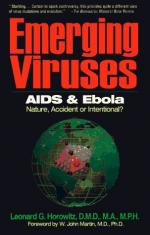|
This section contains 946 words (approx. 4 pages at 300 words per page) |

|
The Ebola virus is one of two members of a family of viruses that is designated as the Filoviridae. The name of the virus comes from a river located in the Democratic Republic of the Congo, where the virus was discovered.
The species of Ebola virus are among a number of viruses that cause a disease that is typified by copious internal bleeding and bleeding from various orifices of the body, including the eyes. The disease can be swiftly devastating and results in death in over 90% of cases.
To date, four species of Ebola virus have been identified, based on differences in their genetic sequences and in the immun reaction they elicit in infected individuals. Three of the species cause disease in humans. These are Ebola-Zaire (isolated in 1976), Ebola-Sudan (also isolated in 1976), and Ebola-Ivory Coast (isolated in 1994). The fourth species, called Ebola-Reston, causes disease in primates...
|
This section contains 946 words (approx. 4 pages at 300 words per page) |

|


